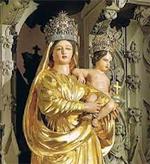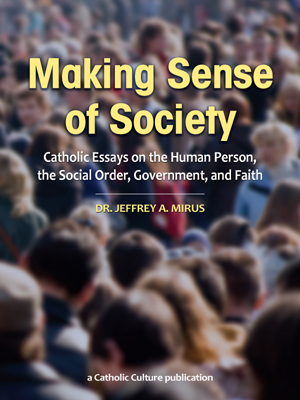Catholic Dictionary
Find accurate definitions of over 5,000 Catholic terms and phrases (including abbreviations). Based on Fr. John Hardon's Modern Catholic Dictionary, © Eternal Life. Used with permission.
Random Term from the Dictionary:
MIRACLES OF CHRIST
They may be divided into five classes: nature miracles; miracles of healing; deliverance of demoniacs; victories over hostile wills; cases of resurrection.
Nature Miracles. Under this head nine miracles may be enumerated.
--Changing of the water into wine at Cana (John 2).
--First miraculous draught of fishes (Luke 5).
--Calming of the tempest (Matthew 8; Mark 4; Luke 8).
--First multiplication of loaves (Matthew 14; Mark 6; Luke 9; John 6).
--Jesus's walking on the water (Matthew 14; Mark 6; John 6).
--Second multiplication of loaves (Matthew 15; Mark 8).
--Stater in the fish's mouth (Matthew 17).
--Cursing of the fig tree (Matthew 21; Mark 11).
--Second miraculous draught of fishes (John 21).
Miracles of Healing. These were numerous during the public life of Our Lord. There are references to a great many cures that are not related in detail (Matthew 4; Luke 4, 6; Mark 6), and twenty special cases are recorded.
--Healing of the nobleman's son (John 4).
--Cure of the mother-in-law of Peter (Matthew 8; Mark 1; Luke 4).
--Cleansing of the leper (Matthew 8; Mark 1; Luke 5).
--Healing of the paralytic (Matthew 9; Mark 2; Luke 5).
--Healing of the sick man at Bethesda (John 5).
--Restoring of the man with the withered hand (Matthew 12; Mark 3; Luke 6).
--Healing of the centurion's servant (Matthew 8; Luke 7).
--Healing of one blind and dumb (Matthew 12; Luke 11).
--Healing of the woman with an issue of blood (Matthew 9; Mark 5; Luke 8).
--Opening of the eyes of two blind men (Matthew 9).
--Cure of the dumb man (Matthew 9).
--Healing of the deaf and dumb man (Mark 7).
--Opening the eyes of one blind at Bethsaida (Mark 8).
--Healing the lunatic child (Matthew 17; Mark 9; Luke 9).
--Opening the eyes of one born blind (John 9).
--Restoring the woman with a spirit of infirmity (Luke 13).
--Healing of the man with the dropsy (Luke 14).
--Cleansing of the ten lepers (Luke 17).
--Opening the eyes of the blind man near Jericho (Matthew 20; Mark 10; Luke 18).
--Healing of Malchus's ear (Luke 22).
Deliverance of Demoniacs. General formulas regarding the driving out of devils (Mark 1) indicate that such acts of deliverance were very numerous during Our Lord's public life. Special cases related are as follows:
--Demoniac at Capernaum (Mark 1; Luke 4).
--Deaf and dumb demoniac (Matthew 12; Luke 11).
--Gerasene demoniacs (Matthew 8; Mark 5; Luke 8).
--Dumb demoniac (Matthew 9).
--Daughter of the Syro-Phoenician woman (Matthew 15; Mark 7).
--Lunatic child (Matthew 17; Mark 9; Luke 9).
--Woman with the spirit of infirmity (Luke 13).
Victories over Hostile Wills. Under this heading Catholic scholars admit a greater or smaller number of miracles; it is not clear in certain cases whether the incidents in which Our Lord wielded extraordinary power over his enemies were cases of supernatural intervention of Divine Power or the natural effects of the ascendancy of his human will over that of other men. Such are the cases mentioned in John (7, 30, and 44; 8, 20, and 59), where the Jews failed to arrest him "because His hour was not yet come," or, in the fourth case, because he hid himself from them. There are two cases that appear to most Catholic commentators to involve a supernatural display of power over wills: 1. the casting out of the vendors (John 2; Matthew 21; Mark 11; Luke 19); 2. the episode of the escape from the hostile crowd at Nazareth (Luke 4).
Cases of Resurrection. Among the signs of his Messiahship which Our Lord gave to the delegates of John the Baptist, we read: "The dead rise again" (Matthew 11; Luke 7). This general statement has made some commentators think that there were cases of resurrection not described in the Gospels. This is possible because the Gospels do not aim at completeness, but the expression quoted would be justified by the three following cases of resurrection, which are related.
--Raising of the daughter of Jairus (Matthew 9; Mark 5; Luke 8).
--Raising of the son of the widow of Naim (Luke 7).
--Raising of Lazarus (John 11).






